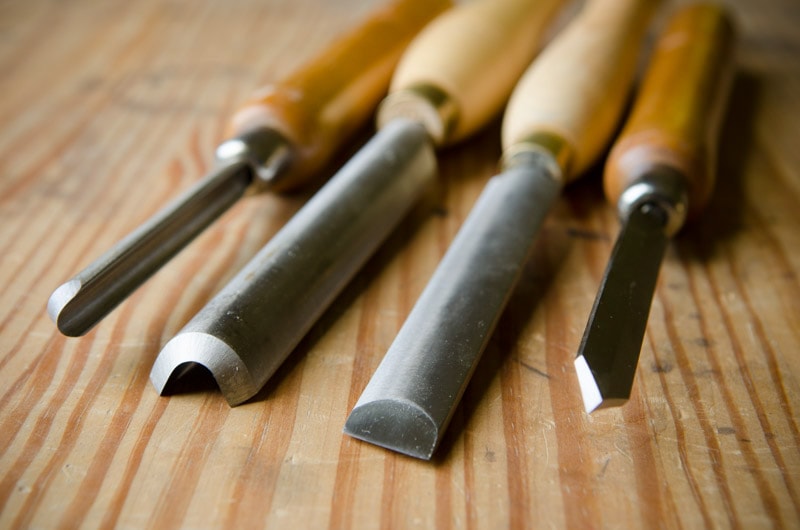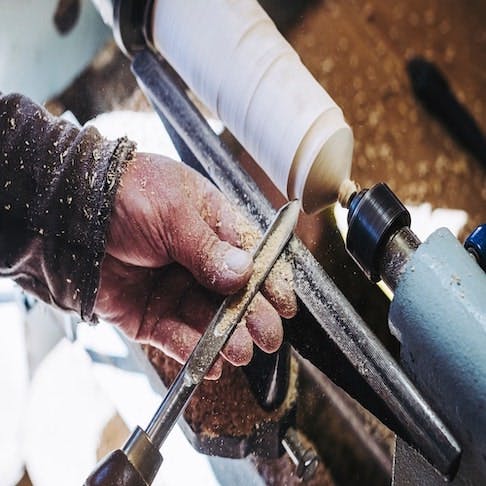Table of Contents
To use wood lathe turning tools, secure the wood and select the appropriate tool for the desired cut. Ensure safety by wearing protective gear.
Wood lathe turning is an essential skill for woodworking enthusiasts. It involves shaping wood into various forms like bowls, spindles, and intricate designs. Mastering this craft requires understanding the tools and techniques. Wood lathe turning tools include gouges, chisels, and scrapers, each serving a specific purpose.
Beginners should start with basic projects to build confidence and skill. Safety is paramount, so always wear protective gear such as goggles and gloves. Regularly maintain and sharpen your tools to ensure precision and efficiency. With practice and patience, wood lathe turning can become a rewarding and creative hobby.

Credit: www.instructables.com
Introduction To Wood Lathe Turning Tools
Wood lathe turning tools help shape wood. These tools are important for making beautiful items. Beginners should learn about the different tools first.
Essential Tools For Getting Started
Begin with a set of basic tools. Gouges are great for roughing out shapes. Skew chisels help make smooth cuts. Parting tools are used to cut wood into sections. Scrapers are useful for fine details. A chuck holds the wood securely.
Safety First: Preparing Your Workspace
Always wear safety goggles to protect your eyes. Use ear protection to guard against loud noises. Make sure your workspace is clean. Keep tools within easy reach. Ensure the lathe is stable and secure. Wear tight clothing to avoid getting caught.

Credit: woodandshop.com
Selecting The Right Wood For Turning
Different projects need different types of wood. Softwoods like pine are easy to turn. They are good for beginners. Hardwoods like oak are tougher to turn. They make strong, long-lasting items. Fruitwoods like apple are great for detailed work. They have fine grains.
Start by cutting the wood to size. Use a saw to make it a cylinder shape. Remove any bark and knots. These can cause problems. Sand the wood to smooth it out. Make sure the wood is dry. Wet wood can warp and crack.
Getting To Know Your Tools
Mastering wood lathe turning tools enhances your woodworking projects. Learn the techniques to shape, carve, and refine wood precisely. Boost your craftsmanship by understanding each tool’s unique function and application.
The Gouge: Shapes And Sizes
The gouge is a very important tool. It comes in different shapes and sizes. A roughing gouge is used to make wood round. A spindle gouge is perfect for detailed work. A bowl gouge is used for making bowls. Each gouge has a special purpose. Choosing the right gouge makes the work easier.
Skew Chisel: Precision And Technique
The skew chisel is great for making smooth cuts. It is used for fine details. Holding the chisel at the right angle is very important. Practice helps to master the technique. The skew chisel can create beads and V-cuts. It requires patience and skill to use well.
Parting Tools And Scrapers: The Finishing Touch
Parting tools are used to cut off pieces of wood. They are also used to make grooves. Scrapers smooth out the wood surface. Both tools are important for finishing. They help to give the final shape to the wood. Using these tools makes the project look complete and polished.
Sharpening Your Tools
A good sharpening station is important. Place it near your lathe. Ensure it has proper lighting. Use a sturdy bench or table. Keep all your sharpening tools organized. A bench grinder works well. Add a jig for consistent angles. Safety gear is necessary. Wear goggles and gloves. Always keep a first aid kit nearby. This setup helps in efficient sharpening.
First, secure the tool in the jig. Turn on the grinder. Lightly press the tool against the wheel. Move it back and forth. Maintain a consistent angle. Check the edge often. Repeat until sharp. Dip the tool in water. This cools it down. Dry the tool well. Store it safely. A sharp tool cuts better. It also lasts longer.
Mounting The Wood On The Lathe
Place the wood piece between the headstock and the tailstock. Make sure it is centered. Tighten the tailstock to hold the wood firmly. Use a chuck or faceplate for better grip. Check the wood piece is secure before starting.
Set the tool rest close to the wood piece. The distance should be about 1/8 inch. Adjust the height so the tool meets the wood at the center. Lock the tool rest in place. Move it as needed while turning the wood.

Credit: www.xometry.com
Basic Turning Techniques
Start by choosing the right tool. Use a roughing gouge for this step. Place the tool on the tool rest. Move the tool slowly into the wood. Keep your hands steady. Remove the outer layers of wood. Shape the wood into a rough cylinder. Check the shape often. Adjust as needed. Make sure not to rush. Safety is key.
Use a spindle gouge for curves. For cylinders, use a skew chisel. Hold the tool at a 45-degree angle. Move the tool smoothly. Keep the tool rest close to the wood. Work in small sections. Check your progress often. Make gentle cuts. Patience is important. Practice makes perfect.
Advanced Turning Techniques
Bowl turning needs a special touch. Start with a rough blank. Secure it on the lathe. Use a bowl gouge for shaping. Work from the center outwards. Keep your tools sharp. This prevents accidents. Control the speed of the lathe. A high speed can cause damage. Move the tool slowly. Check your progress often. Use sandpaper for a smooth finish. Apply wood finish to protect the bowl.
Spindle turning is different. Use a spindle roughing gouge. This shapes the wood. Detail gouges add fine touches. Keep the lathe speed medium. This helps control. Parting tools are useful. They make deep cuts. Skew chisels help with smooth cuts. Practice makes perfect. Always wear safety gear. This includes goggles and gloves. Clean your tools after use. They last longer.
Finishing Your Project
Start with a coarse grit sandpaper. This helps to remove rough spots. Gradually move to finer grits. Each step makes the wood smoother. Sand with the grain. This prevents scratches. Use a sanding block for flat surfaces. It helps to keep the wood even. For curves, use flexible sandpaper. Change the paper often. Worn paper does not work well.
Choose the right finish for your project. Oil finishes are easy to apply. They give a natural look. Varnishes and lacquers offer more protection. Apply thin coats. Let each coat dry completely. Sand lightly between coats. This helps the next coat stick better. Use a clean brush or cloth. Wipe away dust before applying the finish. This ensures a smooth, shiny surface.
Frequently Asked Questions
What Wood Turning Tools Should A Beginner Use?
Beginners should use a spindle gouge, roughing gouge, parting tool, bowl gouge, and a skew chisel for woodturning.
What Are The Four Basic Tools You Need When Using The Wood Lathe?
The four basic tools for wood lathe use are gouges, chisels, parting tools, and scrapers. These tools help shape and refine wood projects effectively.
How To Set Up Lathe Tools For Turning?
Mount the tool securely in the tool holder. Adjust the tool height to the spindle center. Position the tool at a right angle to the workpiece. Set the cutting depth and speed. Test the setup with a light cut.
What Is The Proper Angle For A Wood Lathe Tool?
The proper angle for a wood lathe tool is typically between 25 and 40 degrees. This range ensures efficient cutting and smooth finishes. Adjust the angle based on the type of wood and desired outcome. Proper sharpening and angle maintenance are crucial for optimal performance.
Conclusion
Mastering wood lathe turning tools enhances your woodworking skills. Practice regularly and follow safety guidelines. Experiment with different techniques to create unique pieces. With patience and dedication, you’ll see significant improvement. Happy turning, and enjoy your woodworking journey!
